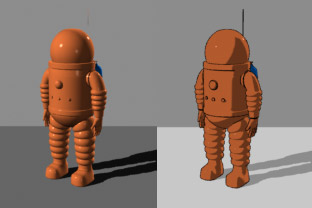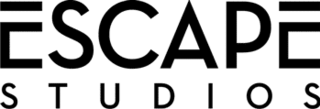Related Research Articles

Animation is a method by which still figures are manipulated to appear as moving images. In traditional animation, images are drawn or painted by hand on transparent celluloid sheets to be photographed and exhibited on film. Today, most animations are made with computer-generated imagery (CGI). Computer animation can be very detailed 3D animation, while 2D computer animation can be used for stylistic reasons, low bandwidth, or faster real-time renderings. Other common animation methods apply a stop motion technique to two- and three-dimensional objects like paper cutouts, puppets, or clay figures.

Sir Ian Livingstone CBE is an English fantasy author and entrepreneur. Along with Steve Jackson, he is the co-founder of a series of role-playing gamebooks, Fighting Fantasy, and the author of many books within that series. He is also one of the co-founders of prominent games company Games Workshop.

Autodesk Maya, commonly shortened to just Maya, is a 3D computer graphics application that runs on Windows, macOS and Linux, originally developed by Alias and currently owned and developed by Autodesk. It is used to create assets for interactive 3D applications, animated films, TV series, and visual effects.

Tron is a 1982 American science fiction action-adventure film written and directed by Steven Lisberger from a story by Lisberger and Bonnie MacBird. The film stars Jeff Bridges as Kevin Flynn, a computer programmer and video game developer who is transported inside the software world of a mainframe computer where he interacts with programs in his attempt to escape; it also stars Bruce Boxleitner, David Warner, Cindy Morgan, and Barnard Hughes. Tron, along with The Last Starfighter, has the distinction of being one of cinema's earliest films to use extensive computer-generated imagery (CGI).
Visual effects is the process by which imagery is created or manipulated outside the context of a live-action shot in filmmaking and video production. The integration of live-action footage and other live-action footage or CGI elements to create realistic imagery is called VFX.
This is a chronological list of films and television programs that have been recognized as being pioneering in their use of computer animation.

Non-photorealistic rendering (NPR) is an area of computer graphics that focuses on enabling a wide variety of expressive styles for digital art, in contrast to traditional computer graphics, which focuses on photorealism. NPR is inspired by other artistic modes such as painting, drawing, technical illustration, and animated cartoons. NPR has appeared in movies and video games in the form of cel-shaded animation as well as in scientific visualization, architectural illustration and experimental animation.

Motion graphic design, also known as motion design, is a subset of graphic design in that it uses graphic design principles in a filmmaking or video production context through the use of animation or filmic techniques. Examples include the kinetic typography and graphics used in film and television opening sequences, and station identification logos of some television channels.
Thomas Albert "Tom" DeFanti is an American computer graphics researcher and pioneer. His work has ranged from early computer animation, to scientific visualization, virtual reality, and grid computing. He is a distinguished professor of Computer Science at the University of Illinois at Chicago, and a research scientist at the California Institute for Telecommunications and Information Technology (Calit2).

Digital Effects Inc. was an early and innovative computer animation studio at 321 West 44th street in New York City. It was the first computer graphics house in New York City when it opened in 1978, and operated until 1986. It was founded by Judson Rosebush, Jeff Kleiser, Don Leich, David Cox, Bob Hoffman, Jan Prins, and others. Many of the original group came from Syracuse University, where Rosebush taught computer graphics. Rosebush developed the animation software APL Visions and FORTRAN Visions. Kleiser later went on to found Kleiser-Walczak Construction Company, which experimented with creating synthespians and made the animation for Monsters of Grace.

3D computer graphics, sometimes called CGI, 3D-CGI or three-dimensional computer graphics, are graphics that use a three-dimensional representation of geometric data that is stored in the computer for the purposes of performing calculations and rendering 2D images. The resulting images may be stored for viewing later or displayed in real time. Unlike 3D film and similar techniques, the result is two-dimensional, without the illusion of being solid.

Escape Studios is a visual effects academy situated in High Holborn, London, offering short courses and degrees at undergraduate and postgraduate level. A subsidiary of Pearson College London since 2013, Escape Studios' primary offering includes study programmes in Visual Effects (VFX), Game Art and Animation, with short courses available in Motion Graphics. Pearson College London is part of Pearson plc, and is the only FTSE 100 company in the UK to design and deliver degrees. Since the foundation of Escape Studios in 2002, more than 4,000 students have passed through its doors, moving into jobs in the animation and visual effects industries.

Computer graphics deals with generating images with the aid of computers. Today, computer graphics is a core technology in digital photography, film, video games, cell phone and computer displays, and many specialized applications. A great deal of specialized hardware and software has been developed, with the displays of most devices being driven by computer graphics hardware. It is a vast and recently developed area of computer science. The phrase was coined in 1960 by computer graphics researchers Verne Hudson and William Fetter of Boeing. It is often abbreviated as CG, or typically in the context of film as computer generated imagery (CGI). The non-artistic aspects of computer graphics are the subject of computer science research.

Terrence Masson is an American computer scientist, specializing in graphic design, computer animation and image analysis. He is the chair of the MFA Computer Arts Department at the School of Visual Arts in New York City. He was also founder and CEO of Building Conversation, an augmented reality company located in Boston, MA. He was both the ACM SIGGRAPH 2006 Computer Animation Festival Chair and 2010 Conference Chair. He also wrote the widely acclaimed book CG 101: A Computer Graphics Industry Reference, and has contributed to films, television programs and video games.
The history of computer animation began as early as the 1940s and 1950s, when people began to experiment with computer graphics – most notably by John Whitney. It was only by the early 1960s when digital computers had become widely established, that new avenues for innovative computer graphics blossomed. Initially, uses were mainly for scientific, engineering and other research purposes, but artistic experimentation began to make its appearance by the mid-1960s – most notably by Dr Thomas Calvert. By the mid-1970s, many such efforts were beginning to enter into public media. Much computer graphics at this time involved 2-dimensional imagery, though increasingly as computer power improved, efforts to achieve 3-dimensional realism became the emphasis. By the late 1980s, photo-realistic 3D was beginning to appear in film movies, and by mid-1990s had developed to the point where 3D animation could be used for entire feature film production.

Computer-generated imagery (CGI) is the use of computer graphics to create or contribute to images in art, printed media, video games, simulators, computer animation and VFX in films, television programs, shorts, commercials, and videos. The images may be dynamic or static, and may be two-dimensional (2D), although the term "CGI" is most commonly used to refer to the 3-D computer graphics used for creating characters, scenes and special effects in films and television, which is described as "CGI animation".
GenArts, Inc. was a Cambridge, Massachusetts-based developer of visual effects software for the film, broadcast and advertising industries. A majority of traditional video content such as movies, commercials, television shows, newscasts and music videos included at least some special effects created in a GenArts product. GenArts created visual effects software and plugins that integrate visual effects such as glows, lightning, fire and fluids into post-production video editing software from companies like Apple, Adobe, Autodesk and The Foundry.

Stephen Rosenbaum is an American visual effects artist and supervisor, and has worked on numerous movie, tv and music productions, including six that have won Academy Awards. He has been nominated three times for an Academy Award and two times for a BAFTA Award. He has won both awards twice for his contributions on Forrest Gump and Avatar, and has played artist and supervisor roles on such pioneering films as Jurassic Park, Terminator 2: Judgment Day, The Abyss, X2: X-Men United, Death Becomes Her, Contact and The Perfect Storm.
Paul J. Franklin is an English visual effects supervisor who has worked with visual effects since the 1990s. Franklin won the Academy Award for Best Visual Effects and the BAFTA Award for Best Special Visual Effects for Inception (2010), and won a second Academy Award for Best Visual Effects for Interstellar (2014). He shared the wins with Andrew Lockley, Peter Bebb, and Chris Corbould. Franklin has also been nominated for an Academy Award for The Dark Knight (2008). He was nominated for BAFTA Awards for Batman Begins, The Dark Knight (2008), and The Dark Knight Rises (2012).

A cutscene or event scene is a sequence in a video game that is not interactive, interrupting the gameplay. Such scenes are used to show conversations between characters, set the mood, reward the player, introduce newer models and gameplay elements, show the effects of a player's actions, create emotional connections, improve pacing or foreshadow future events.
References
- ↑ "3D World 98's CGI Ivy League table" . Retrieved 6 January 2008.
- ↑ "NCCA People A-Z" . Retrieved 6 August 2012.
- 1 2 Comninos, P.; McLoughlin, L.; Anderson, E.F. (2010), "Educating technophile artists and artophile technologists: A successful experiment in higher education" (PDF), Computers & Graphics, Elsevier, 34 (6): 780–790, doi:10.1016/j.cag.2010.08.008
- ↑ "2001 RAE Results in Art and Design" . Retrieved 6 January 2008.[ permanent dead link ]
- ↑ "Livingstone-Hope Skills Review of Video Games and Visual Effects". Archived from the original on 10 January 2012. Retrieved 9 December 2011.
- ↑ Livingstone, I.; Hope, A. (2011), Next Gen: Transforming the UK into the world's leading talent hub for the video games and visual effects industries, National Endowment for Science Technology and the Arts, archived from the original on 2 December 2011, retrieved 9 December 2011
- ↑ "Winners of the Queen's Anniversary Prizes announced" . Retrieved 12 February 2011.